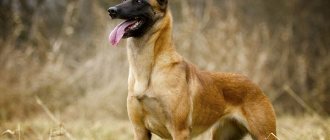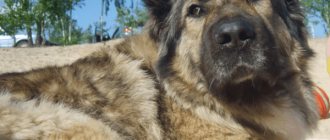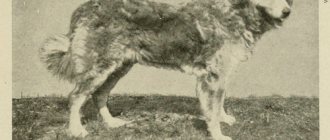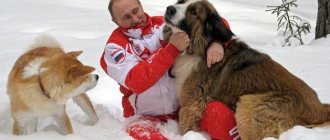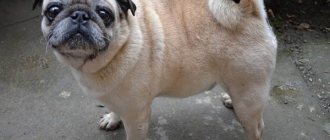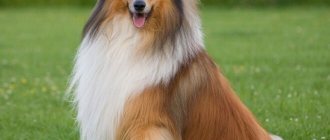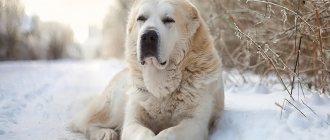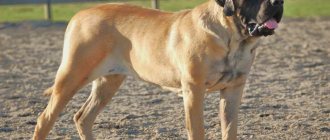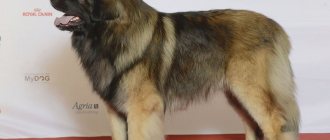Brief description of the breed
What is the actual country of origin?
Great Britain
What is the country of origin according to the FCI?
Great Britain
When did the breed appear?
1911
How long does he live?
from 12 to 14 years
How much does a male dog weigh?
from 8 to 11 kg
How much does the bitch weigh?
from 7 to 10 kg
What is the height (height at withers) of a male dog?
from 35 to 39 cm
What is the height (height at withers) of the bitch?
from 33 to 37 cm
How much does a puppy with documents cost?
from 20 to 90 thousand rubles
What is the price of a puppy without documents?
from 10 to 20 thousand rubles
Shelties are relatively small, graceful dogs native to the northern Shetland Islands. For many centuries, this breed was known only to indigenous people. She served faithfully on farms as a caretaker and shepherd. But after international recognition, the breed quickly gained wide popularity around the world. Her sharp mind, loyalty and attractive appearance are highly valued to this day.
How to choose a good puppy of this breed
The rules for choosing a future friend are generally common to all breeds. In the case of a dwarf Scottish Shepherd, you need to pay attention to the following parameters:
- The puppy should look healthy. This means that the baby is actively playing, the coat is soft and shiny, and the puppy eats with appetite. There is no diarrhea, vomiting or unpleasant odor. Clean eyes, nose, mouth, ears. If something worries you, it’s better to immediately ask the breeder a question.
- The puppy must have all vaccinations in accordance with its age. Dogs are vaccinated from 8 weeks. It is highly undesirable to adopt a puppy without vaccinations.
- A small collie should be treated against worms and parasites with the same drugs that can be used by a Sheltie. The antiparasitic drug should not contain the active substance Ivermectin.
- The breeder should easily introduce future owners to the puppy’s parents. Parents should be human-friendly, active and healthy. It is important that they are tested for genetic diseases of the breed.
- It's better not to pick up your baby too early. The optimal age for moving is 8-9 weeks.
Sheltie puppies are adorable
The price of mini collie puppies is from 20,000 rubles. It is better to refrain from buying a dog for less money. Together with the breed, future owners buy a guarantee for the health of the future family member and a certain character.
A Sheltie can be your best friend for years to come. All the love and care given to the dog will be returned a hundredfold. Shetland Sheepdogs are very affectionate with their family members and will never let you get bored.
Video
* We invite you to watch a video about the Sheltie . In fact, in front of you is a playlist in which you can select and watch any of 20 videos about a given dog breed by simply clicking on the button in the upper right corner of the window. In addition, the material contains quite a lot of photos. By looking at them you can find out what a Sheltie looks like.
In this article:
|
Rate the material!
[Total votes: 2 Average: 3]
Training and education
Alaskan Klee Kai (mini husky): description of the dog breed
The surest strategy for raising and training small collies is to establish strong friendships. Shelties are shepherd dogs, which means they are very smart and unforgiving of violence. There should be no rudeness in communicating with your pet. It is enough to point out mistakes in time and praise when the dog does everything correctly.
Important! Since Shelties are very attached to their owners, the best method of influencing the dog is usually praise. Sometimes mini collies are ready to do more and better for a favorite toy or a piece of food.
It is worth remembering that training is only an element of education and is necessary for a comfortable life with a dog. First of all, the Sheltie should be taught the “voice” and “quiet” commands. This will help in the fight against uncontrollable barking. The necessary commands will be “no”, “no” and “come to me”. They are needed for safety while walking.
Sheltie Origin History
Small fluffy dogs that look like collies have lived next to humans for many centuries. They perfectly performed difficult shepherding work in difficult climatic conditions. The breed received its modern name only in the twentieth century, when it became known throughout the world. The Sheltie's homeland is the islands off the coast of Scotland, which are called the Shetland Islands.
There are many unclear points in the history of the Sheltie's origin. For example, it is still difficult for specialists to name the real ancestors of these animals. Some believe that they were Scandinavian dogs, while others are sure that the ancestors were Yakka dogs. The latter breed has long been extinct. Outwardly, Shelties are very reminiscent of collie dogs.
The indigenous people of the islands used to call these small dogs "Tuni Dog" or "Fairy Dog". The last name translates as “magic dog”. Shelties earned this nickname for their sharp mind, unquestioning obedience and high efficiency. At that time, they worked a lot: they guarded residential buildings and agricultural buildings, looked after sheep, and helped shepherds.
Dogs of that time were far from modern ones. Until the twentieth century, these animals were crossed with various breeds: Spitz, Schipperke, etc. The development of the modern breed began only when the Sheltie began to cope poorly with herding work. The herds of sheep were numerous, such small dogs were simply unable to cope with them. Shelties quickly lost their popularity among farmers.
The population of the breed began to decline rapidly. She was saved by true Sheltie connoisseurs, who united in an amateur club. In England the club was created in 1914. In the same year, the dogs received their modern name. After the war, Shelties began to be crossed with long-haired collies. After this, the dogs acquired their current appearance. In 1948, breed standards were finally finalized.
Sheltie - description of the breed
If earlier Sheltie dogs were valued solely for their working qualities, today these animals are also considered for their external attractiveness. Sheltie is a beautiful dog. She is distinguished by an elegant physique and proportionality. The dog's back is flat, slightly curved in the lumbar region. The chest is deep, the tail is set low. The tip of the tail may be slightly curved, but not curled.
Shelties have fairly strong hind and forelimbs. They are muscular, with large bones (though the bones are not heavy at all). These dogs have pronounced hock joints. The animal's paws follow the shape of an oval and have curved toes. The toes fit well together. In general, the Sheltie's build is athletic and strong. The dog remains highly mobile until the end of its days.
The Sheltie's muzzle is very similar to that of a collie. The dog's head is long, tapering towards the nose, and the neck is long and muscular. The length of the skull and muzzle is the same. These small dogs are very cute. They have a small black nose, straight jaws, small ears, and “smart” almond-shaped eyes. Eye color is usually very dark brown. However, there are representatives of the breed with blue eyes.
Sheltie dogs have amazing coats. It is long, thick, shiny. The wool is hard to the touch. It grows almost throughout the animal's body. The undercoat is thick. It makes the dog resistant to cold weather. The coat color is rich in various shades: from silver-blue to mahogany. Dogs almost always have a multi-colored pattern or various markings.
Main characteristics and standard
Description The Sheltie dog breed is, first of all, beautiful, stately, elegant dogs, miniature in size for working dogs, well-proportioned and well-built, with a beautiful and rich fur coat. The collar and natural trouser-like fringes on the limbs give the appearance of an aristocrat.
Characteristics of the Sheltie dog breed - describes them as animals with increased responsibility - possessing vigilance and observation.
The interesting and attractive appearance of the animal has not yet left anyone indifferent.
- Head: Sheltie and the breed standard provide for a wedge-shaped head, which necessarily has a narrowing towards the nose. The tubercle at the base of the skull is not lost and is practically invisible. The width of the forehead is average, the muzzle is more rounded, flat cheekbones, elongated. Full color of the nose, lips and eyelids, always black.
- Jaw: of medium power, but with good strength, the chin is visually visible. Tight lips, correct scissor bite, complete set of teeth. The fangs are snow-white, medium in size, number of teeth - 42.
- Eyes: predominantly slanted, medium size, brown in color. Representatives of Merle (blue) - blue, may have two sets of brown and blue, or are not pigmented with full color. The gaze is always direct and attentive, conscious.
- Ears: medium size, close set, widening towards the base - triangle shape. Movable, dense cartilage, in quiet sucking directed downwards, when paying attention - alert, looking forward. The corner may bend slightly towards the bottom.
- Neck: fairly large, strong, well muscled, beautifully arched. Outwardly it looks like an aristocrat's stance.
- Limbs, paws: straight, mostly lean muscles, set parallel, without eversion. The paws are rounded, compressed into a tight ball. Fingers with hard and tough claws are black in color. The thigh is wide, strong, the muscles are pronounced, dry.
- Chest: deep, reaching to the level of the elbow. Good size ribs.
- Back: straight, not elongated, strong with good muscles, smooth transition into the lower back.
- Loin: convex type, medium width, strong.
- Tail: overall length, located at the level of the hock joint, saber-shaped. Completely covered with abundant hair. There is a slight curve towards the top. Does not rise above the level of the back.
- Movements: graceful, free, fast, with good range. Moves easily and naturally.
The Sheltie's standard weight and height should be:
- Males – 35 – 38 cm; Weight – 10 – 12 kg;
- Girls – 32 -35 cm; 8 – 10.5 kg.
Colors
When describing the breed, special attention is paid to its coat and all kinds of colors. The coat is externally beautiful, well-groomed, shiny, straight, and falls beautifully down. There are several colors for Sheltie:
There are several colors for Sheltie:
- Tricolor (tricolor) - the leading color is black, spots from brown to red-red colors are distributed throughout the body, there is a slight white color.
- “Blue Merle” (blue marble) – wool of a bluish tint, beautiful tints of silver, numerous spots of black, not large, with a smooth gradient. There may be small amounts of red and white spots.
- Sable - from sandy light to bright gold and fiery red. The main condition is brightness and the absence of gray spots on the body.
- Black and white: there may be brown spots, a bright representative, pure black with white spots looks more impressive.
The marbled Sheltie is one of the favorites among owners; the color looks unusual and attractive; such dogs can have different eyes, or pure blue. White heels are desirable for all animals: on the chest, belly and paws (except black and brown).
Popular Sheltie colors
Shelties have beautiful coats. They have it of a double type. The undercoat is thick, soft and pleasant to the touch. The outer hair is long and coarse. The coat is very similar to that of a collie. The dog’s neck is decorated with a lush mane, and its hips are decorated with wide “pants.” Nature has rewarded representatives of this breed with a wide variety of colors. All possible options are necessarily indicated in the official standard.
The color of a dog of this breed can be three-color in the following variants:
- Bright red with white and black spots;
- Sable with white spots and tan;
- Sable with blue and black.
If now the Sheltie's long hair almost always serves as decoration, then previously it saved the animal from the frost. The undercoat allows the dog to confidently float on the water. The mane and frill give Sheltie dogs a special charm. They stand out against the background of the rest of the cover, mostly painted white. The three-color coloring produces a positive effect; outwardly the dog looks good-natured.
A real Sheltie dog must be tri-colored and only with the colors specified in the standard. Any deviations in color will be considered a defect in the breed. It is also very undesirable for Shelties to appear in gray or wolf colors. If the animal is bicolor, then there should be no white spots on its body. If the color is marbled, there should be no black marks on the body.
Coat and colors
The Sheltie's double coat consists of a hard, long, straight guard and a soft, dense, short undercoat. A noticeable decoration is the lush mane and collar, well-furred limbs and tail. The fur on the face is always short.
Many colors are allowed; for convenience, they are divided into groups:
- Sable - pure shades from fawn to bright red (wolf and gray are undesirable);
- Bicolor – black with red or white;
- Tricolor - black with red and brown markings;
- Merle is a silver-blue merle with black flecks.
The presence of white spots is allowed on the face, chest, and paws; on the body they are extremely undesirable.
Sheltie character and habits
A Sheltie dog can be briefly characterized by the following qualities:
- Good-natured;
- Responsive;
- Energetic;
- Moderately wary;
- Attentive.
Animals of this breed are excellent companions and loyal friends. They are ideal for keeping with a large family. Shelties especially adore children and charge them with their positive energy. Dogs can run and play for hours with children of all ages. Shelties have a good disposition. They are obedient and attentive to their owner. Problems very rarely arise with raising such a pet.
Sheltie dogs love to be in company. They need daily play walks. Dogs have a great need for communication and may experience psychological difficulties if such communication is not provided. Such a pet is not suitable for a lonely person who spends most of his time outside the home. If a dog is left alone for a long time, it can begin to damage things: wallpaper on the walls, furniture, shoes, bags and much more.
Shelties adore their owner, his family, and children. With proper upbringing, they will never pretend to be a leader in the family. This is an obedient, responsive dog. She will not only be man's best friend, but also his protector. Shelties have well-developed watchdog qualities. She is wary of strangers and will always guard the territory of her human family.
Representatives of this breed are also sensitive. They sense the mood of their owners and may experience discomfort from this. For example, a dog will be constantly sad if there are frequent scandals or swearing in the house. He needs a calm environment. It is also important for this dog to know that it is loved by its owners. This way the animal will feel much more confident and happier.
Interesting facts about Sheltie
The main charm of the Shetland Sheepdog comes from its coat. It is thick, beautiful and shiny. However, you have to “pay” for such beauty. The Sheltie sheds twice a year - in the spring and at some other specific time of the year (it will depend on the characteristics of the individual dog's body). Shedding occurs profusely. This pet is absolutely not suitable for a person with an allergy to dog hair.
Almost all representatives of the Sheltie breed are very active and sociable. They love to bark. Therefore, their owners often have conflicts with neighbors. To maintain friendly relations with the people around you, the Sheltie needs to be trained. With proper training, a dog will not bark without a reason. To get a good result, training must begin from a very early age.
Sheltie, like many other dogs, love active games. However, these four-legged animals have a certain feature - they love intellectual tasks. The simplest exercises will be boring for Shetland Sheepdogs. Shelties are extremely intelligent and need variety on walks. The tasks should be of interest. If your pet gets bored, he will instantly turn into a stubborn and lazy dog.
Shetland Sheepdogs used to be in great demand. Because of this, their breeding was carried out by completely untrained people. You should not buy Shelties from little-known breeders. In this case, there is a high risk of becoming the owner of an animal with a serious genetic disease. The breeder must be large, verified by other people. Before purchasing, it is advisable to personally read customer reviews.
Mating
Dogs over 18 months old are allowed to breed. In females, as a rule, this is the third sexual heat. The first estrus occurs at the age of 6 to 9 months , depending on the characteristics of the body.
Shelties are bred on the 10th – 12th day of estrus – these are approximate data. Ovulation can occur on the 15th – 18th day of sexual heat, because these are living organisms, it is impossible to accurately predict. A dog does not need to select a time for mating.
Shetland Sheepdogs have a very wide range in the number of puppies per litter. One female can bear 3 - 4 puppies , the other safely gives birth to 6 - 7 .
Before mating, it is recommended that the dog and bitch undergo deworming in order to prevent infection of the offspring.
Read a detailed article on the topic: “Everything you need to know about breeding dogs: appropriate age, what to do if it doesn’t work out, rules and tips.”
Pros and cons of Sheltie
Despite their visual attractiveness, Sheltie dogs have a number of specific disadvantages. The main one is the predisposition to a large list of various diseases. Many dogs of this breed are susceptible to allergies, cataracts, hip dysplasia and various tumors. However, most Sheltie dogs still have good health and high immunity.
The downside of the breed is that it is difficult to care for. The main difficulty lies in caring for the dog's long and thick hair. The pet needs to be brushed and bathed often. He needs quality dog care products. In addition, you will have to endure molting twice a year. The Shetland Sheepdog sheds a lot. If you suffer from allergies, then this dog is definitely not suitable for you.
Otherwise, Sheltie dogs are excellent. They are devoted to their owner, adore children, are obedient and smart. Such a pet will become a guard for the home, a best friend or just a companion in life. Sheltie is unpretentious to food and living conditions. The animal can withstand almost any climatic conditions. Thick fur helps him with this. It saves him from both frost and overheating.
Among the advantages, one cannot fail to note the dog’s stunning exterior. The pet is small, has a luxurious coat and a cute face. The dog's energy is also a plus. Shelties are almost always in a good mood, they are active and playful. They love to walk, learn and carry out various tasks for their owner. The main thing is to devote time to the dog and train him from an early age.
Sheltie breeding
Sheltie breeding is not an easy task. In the process of breeding this breed, the result cannot be predicted. This is because in the past many different breeds of dogs were used to create the Shetland Sheepdog. Therefore, when breeding a Sheltie, puppies may appear completely different from those originally planned. Puppies even from the same litter can be completely different.
To breed a Sheltie, you first need to purchase a female. The puppy must be absolutely healthy and fully meet the official breed standards. In the future, the dog needs to be checked for genetic diseases, because not all of them appear at an early age. The bitch needs to be bred after full puberty, after her second heat. Before meeting your gentleman, it is necessary to undergo general tests to assess the current condition of the bitch.
You also need to take great responsibility when choosing a mate for your dog. The male must be healthy, without visible deviations from the standard. It is advisable to choose an experienced “sire” so that you can familiarize yourself with photographs of his past offspring. The color should be as similar as possible to the color of the bitch. Then the color of the puppies will be predicted.
It may take several meetings with a male dog for a female dog to become pregnant. During pregnancy, the dog will need a special vitamin complex. You can find out from your veterinarian how and what to feed a pregnant Sheltie. After giving birth, the Sheltie will take on most of the responsibilities for caring for the puppies, but she will need the help and support of her owner. Puppies should live in a warm and clean environment.
History of the breed
The Sheltie is a fairly young breed. It was only registered at the beginning of the 20th century. The homeland of the mini collie is the Shetland Islands. The ancestors of the breed are several groups of dogs: Norwegian Buhunds, Yakkas, Icelandic Cattle Dogs and Spitz.
Sheltie is a herding breed
Peasants called Shetland Sheepdogs “tiny dog,” which translates as “tiny dog.” These dogs have always been mini collie, that is, a miniature copy of a collie.
The people who stood at the origins of the breed did not care at all what the dog looked like. Man was only concerned about the working qualities of four-legged shepherds. Shelties helped people herd sheep, goats, ponies and birds. Five small shepherd dogs, without human intervention, could drive a flock of sheep from the mountains to the valleys and back. Shelties also protected gardens and haylofts from feral herbivores and birds, scaring them with loud barks. Shetland farmers valued their helpers very much.
The Sheltie gained popularity in the 19th century. Guests of the islands noted the small fluffy dogs that accompanied local farmers everywhere and showed interest in them. Sailors, travelers and traders lined up for Sheltie puppies to bring such an unusual dog home as a gift.
The peasants realized that selling dogs was a good source of income. Breeders began to actively improve the appearance of Shelties by infusing them with the blood of Pomeranians, Papillons and Spaniels. As a result, the Pygmy Collie lines of the time were very different from each other.
For reference! The Sheltie or Little Collie is a breed that only received an approved standard towards the end of the 20th century.
At the same time, breeding work continued. Since some types resembled collies from a distance, breeders decided to enhance the Sheltie's resemblance to these large, fluffy dogs.
During World War I, breeding was suspended and the world almost lost this interesting breed. Fortunately, a few outstanding representatives remained alive, and the breed survived. The Second World War also almost deprived the world of the Sheltie, but everything worked out again.
The Sheltie's popularity increased greatly in 2005, after the release of the film "Lassie" about a collie dog. Those who could not afford to have a large dog opted for a sheltie, a miniature copy of a collie.
Sheltie care
Like any other dog, the Sheltie needs certain care:
- Combing;
- The washing up;
- Cleaning teeth, ears;
- Nail trims.
The most difficult part of caring for a Shetland Sheepdog is grooming its coat. The coat of this dog is thick and long. It needs to be brushed several times a week. Combing should be done with a comb with long and frequent teeth. The procedure must be performed efficiently. Then tangles will not form, and your pet’s appearance will still be chic.
The advantage of the Sheltie coat is that it practically does not absorb dirt. For this reason, the dog needs to be bathed only twice a month, sometimes once is enough. When bathing, you should use only specialized products for dogs. Shampoos and conditioners made for humans can be harmful. After washing, the Sheltie coat can be dried with a hairdryer.
Grooming should become more frequent during the shedding period. In this case, you will have to comb your pet daily. Another important point in care is to provide the dog with a high level of physical activity. Shelties need frequent and long walks. Walks should be intense and educational. If you don’t have any time for walks, then it’s better to think about buying a dog of a different breed.
To clean teeth, the owner needs to get a special toothbrush. Silicone finger models are most convenient. Ears can be cleaned with a regular cotton swab as they become dirty. The most important aspect of caring for a dog is providing comprehensive nutrition. It should provide the energetic dog’s body with all the necessary vitamins, elements, and minerals. More on nutrition in the next section.
Sheltie diet
You can feed your Shetland Sheepdog commercial food. This makes caring for your dog much easier. Industrial food will contain all the necessary elements to maintain the health and energy of the dog. However, industrial feed must be of the highest quality. Such feeds are expensive and have a high consumption. It is more profitable to feed your Shetland Sheepdog natural food.
The Sheltie's daily diet should include the following foods:
- Meat;
- Fish;
- Cereals;
- Fermented milk products;
- Fruits;
- Vegetables;
- Cereals.
The majority of a Sheltie's diet should consist of meat. The meat does not need to be boiled, much less fried. The meat is offered to the dog raw. You can first cut it into small portions. Meat can be different: chicken, lean pork, beef, turkey, etc. Fish can also be a source of animal protein. Marine is ideal.
For an adult fish, you do not need to cut it into pieces. You just need to first remove the fins and head. You cannot give a puppy a whole carcass. It should be twisted in a meat grinder. In addition to meat, you can offer your pet boiled cereal. Rice, buckwheat, wheat or corn grits are suitable. Sometimes you can add cheese or vegetables to the cereal. Vegetables can be pureed or offered in pieces.
Less often, Shelties can be treated to fruits, berries, and dairy products. These dogs are unpretentious to food. They love to eat a lot and deliciously. There are foods that should not be in any form in a Sheltie's diet. These are tubular bones, pasta, sweets. Also, any smoked foods, spices and salty treats can cause great harm to the dog. You should not feed your pet from a common table.
Diseases and health problems
The Shetland Sheepdog is not a problem-free breed. These dogs are predisposed to many diseases. However, this does not mean that the puppy will necessarily be sick and will constantly require expensive medical procedures. If the parents are healthy and the breeder is responsible and honest, then you can buy a strong and healthy puppy for your family. The main thing is to choose it correctly.
Sheltie dogs are most prone to eye diseases, including hereditary ones. They may have cataracts, entropion, or collie eye abnormality. The last disease is hereditary and is one of the most severe. With such an anomaly, there is a high probability that in the future the puppy will completely lose his sight. A veterinary ophthalmologist can diagnose the anomaly.
Also, some Shelties are diagnosed with progressive retinal atrophy, distichiasis, and corneal dystrophy. These are no less dangerous diseases that can lead to complete or partial blindness. However, with early diagnosis and proper treatment, sad consequences can be avoided. Hearing problems in Shelties are detected much less frequently. Deafness is usually congenital.
Very often, Shetland Sheepdogs suffer from various skin diseases. They are tormented by skin dermatitis, dermatomyositis, and cutaneous histiocytomas. The skin of this dog is quite sensitive. Rarely, representatives of this breed can be diagnosed with dwarfism, hemophilia, and muscular dystrophy. Some of these ailments appear as early as puppyhood.
How to choose the right puppy
Age
The optimal age for a Sheltie to come to a new home is from 1.5 to 4 months . The lower age limit is determined by the child’s psychological unpreparedness to be far from his mother and from his usual environment. If you have a very small puppy in your house, then provide him with affection and a cozy, quiet place away from the noise and bustle. He may whine (“cry”) a lot, especially on the first night - be tolerant of these manifestations of melancholy and take advantage of the opportunity to establish an emotional connection.
From one and a half to four months, the puppy develops its character and certain habits that are very difficult to correct at a later age . It is during this period of time that you need to establish a trusting relationship with the new family pet, through tactile contact (caressing, stroking) and constant communication. Begin to “instill” in your puppy the foundations and skills that are acceptable to you - knowledge of the place, optimal times for feeding and walking, basic commands.
If you take into your home an individual older than 16 weeks, be prepared for difficulties - the puppy needs more time to adapt to the new home and the individual characteristics of the owner. From this age, it is necessary to consolidate the basics of training and education that have already been completed.
Choosing a puppy
You should not give in to impulse and buy an animal “cheaply” at poultry markets. Only an experienced breeder will be able to provide you with the puppy’s pedigree and guarantee the purebred and health of the future pet.
What to look for when choosing a Sheltie:
- Clean eyes and ears
- Color (there should be no impurities unusual for the breed)
- Weight (an eight week old puppy will weigh 1.2-2 kilograms)
- In purebred shelties, already in puppyhood, a strong physique, symmetrical body features, and straight limbs are clearly visible.
- Pay attention to the pedigree and previous brood
- Ask the breeder for a provenance card
Do you know what the life expectancy of a golden retriever is? They live longer than you might think! Click and find out in our description of this wonderful breed.
A devoted friend with a charming appearance, but not the simplest character, the Shar Pei is a very balanced and smart dog. Can you handle her training? Let's try to answer using this link.
Prices
A purebred Sheltie will cost you 10-30 thousand rubles . Do not try to save money - there is a high risk of purchasing an unhealthy puppy, with developmental anomalies and significant shortcomings. Private “breeders” selling in markets skimp on food, vitamins, and vaccinations, which negatively affects the health of their pets.
How to prepare your home for the arrival of a Sheltie?
The breed's hyperactivity can contribute to injuries in clumsy babies - so make sure to ensure your pet's safety - surfaces on which the puppy can jump should not be slippery, and objects that can be swallowed should be eliminated.
A Shetland Sheepdog puppy is the same as a baby, so everything in your home needs to be prepared properly.
Immediately remove valuables and expensive shoes - otherwise everything will be tasted, torn and swallowed. Toys for fluffies can be washed apples, carrots and potatoes, or special devices from a pet store. Cables should be kept out of the Sheltie's reach - these dogs will happily chew them and chase cords around the house.
